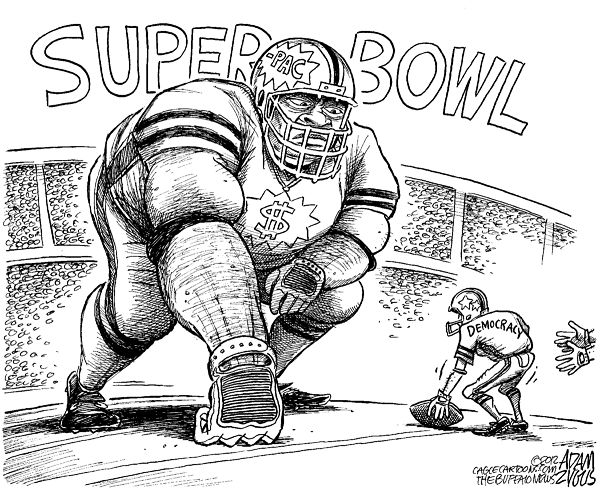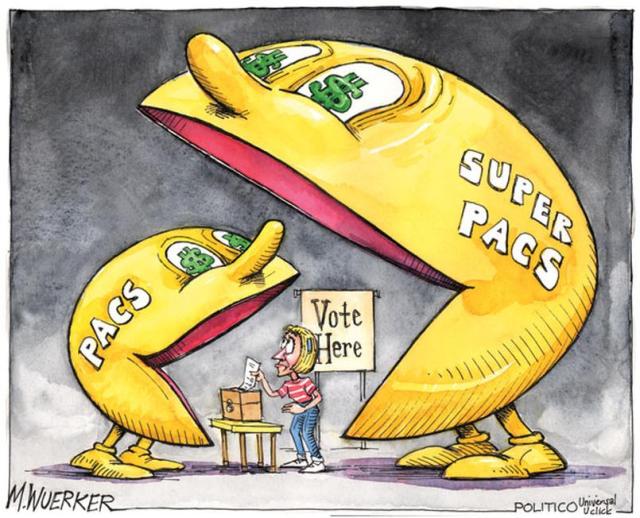Who Will Protect Elections From U.S. Oligarchs?
By Paul Street/ Truthdig/ April 18, 2018
I recently heard on cable news that special counsel Robert Mueller wanted to interview some “Russian oligarchs” about their supposed influence on the 2016 U.S. presidential election.
Liberal talking heads at such organizations as MSNBC and CNN keep warning that nothing has been done yet to protect the integrity of our voting process against “Russian interference” as the 2018 midterm elections loom ever closer on the nation’s horizon.
What about the American oligarchs, I wondered, people like businessman Richard Uihlein, who regularly distort U.S. elections at every level—local, state and federal? Who will protect our “democracy” from the plutocratic “wealth primary” power of the American oligarchy?
If you are like most U.S. citizens, you’ve never heard of Richard Uihlein. An heir to the Milwaukee-based Schlitz beer fortune, Uihlein is the billionaire CEO of Uline Inc., a private, family-owned Wisconsin company that sells shipping and packaging materials to the tune of $2 billion in annual revenue. He lives in a mansion in Lake Forest, a hyper-opulent preserve north of Chicago.
So far, Uihlein is the top political contributor in the 2018 federal U.S. election cycle, at $21 million. In 2016, however, he was just the nation’s ninth biggest political investor. Above him on the plutocratic “wealth primary” scale stood the San Francisco hedge fund billionaire Tom Steyer ($91 million, all to Democratic candidates and Democratic Party-affiliated “liberal outside groups”); Las Vegas billionaire casino owner Sheldon Adelson ($83 million to Republicans and the right); Florida billionaire financier Donald Sussman ($42 million to Democrats and “liberal” groups); Chicago multimillionaire media mogul Fred Eychaner ($38 million to Democrats and “liberal” groups); Dustin Moskovitz, a co-founder of Facebook and the “world’s youngest self-made billionaire” ($27 million to Democrats and “liberal” groups); billionaire mathematician and hedge fund manager James Simons ($27 million to Democrats and “liberal” groups); billionaire hedge fund manager Paul Singer ($26 million to Republicans and right-wing groups); and billionaire right-wing hedge fund manager Robert Mercer ($26 million to Republicans and right-wing groups). Michael Bloomberg rounded out the top 10 list at a cool $23,786,083.
These megadonors are the superrich cream atop a deep plutocratic pitcher. The CRP’s list of the top 100 individual contributors to federal candidates during the 2016 election cycle ends with Karen Wright, CEO of a leading gas-compressor manufacturer. She gave a whopping $2.2 million to Republicans and the right.
How are such ridiculously astronomical political investments—far beyond the capacity of all but a super-opulent minority of U.S. citizens—possible under U.S. law? Aren’t there limits on how much rich people can spend on U.S. elections?

Not really. Not for rich people whose agents know how get past the nation’s porous regulations. Federal law sets a $2,500 per-person, per-election limit on how much a donor can give to a federal candidate, a $30,800 per-person, per-year limit on donations to national party committees, and a $10,000 total limit on per-person contributions to state, district or local party committees.
But the rules change when it comes to technically “independent” nonparty and “outside” groups called political action committees, known as PACs. A person can give as much as $5,000 to a PAC that contributes directly to candidates. And there are no limits whatsoever on how much a person can give to a PAC that declares it will spend its money totally independently from a candidate’s campaign. These “independent expenditure” groups, which can receive unlimited contributions from individuals, corporations or unions, are commonly called super PACs.
Some nonprofit groups, called “social welfare” organizations or “501(c)(4) groups,” can also accept unlimited contributions. The primary purpose of these groups cannot technically be political, but they can spend substantial amounts on political activities, such as TV commercials.
Adding to the plutocratic muddle, the Supreme Court’s infamous 2010 Citizens United decision overthrew a federal ban on corporations and unions making independent expenditures and financing electioneering communications. It gave corporations and unions the green light to spend unlimited sums on ads and other political tools calling for the election or defeat of individual candidates.
This has opened the door to astonishing levels of private spending in the nation’s public elections. “During the 2016 election cycle,” CRP staffer Bob Biersack notes, “the top 20 individual donors (whose contributions were disclosed) gave more than $500 million combined to political organizations. The 20 largest organizational donors also gave a total of more than $500 million, and more than $1 billion came from the top 40 donors. … At a time when Donald Trump and Bernie Sanders were confirming that large numbers of people donating small amounts could fund successful campaigns, the extraordinary role being played by the very few donors who give the most may be the most important element in this new era.”
Thanks to the problem of “dark money,” moreover, we don’t have a complete record of which rich people give how much to which candidates. While super PACS must disclose their donors, 501(c)(4)s are not required to do so. These nondisclosing organizations engage in numerous political activities: buying ads that advocate for or against a candidate, running phone banks, making contributions to super PACs (!) and more.
It’s reached the point where, as a former Republican chairman of the Federal Election Commission told The New Yorker’s Jane Mayer last year, “a single billionaire can write an eight-figure check and put not just their thumb but their whole hand on the scale—and we often have no idea who they are. … [A] random billionaire can change politics and public policy—to sweep everything else off the table—even if they don’t speak publicly, and even if there’s almost no public awareness of his or her views.”
Their right to not disclose means that the campaign finance data listed above significantly underestimates total political investments made by the nation’s leading election donors. (CONTINUED-CLICK HERE TO READ ENTIRE ARTICLE)


Arlen Grossman, I am not saying that this is the case, however, what are your thoughts if there was a double standard in the sense that excessive contributions to a candidate from one Party faced a lesser penalty than a candidate who ran representing another Party? I would classify as that as a serious form of hypocrisy.
Sorry, Jeffrey. I don’t understand your question. Contributions to both parties should be and are treated the same.
Arlen Grossman, I will not dispute that point. Having said that, if there was discrimination against one person from one Party who violated campaign finance law, with a person from another Party getting a pass for the same crime, what are your views in that scenario? Dinesh D’Souza, a conservative, violated campaign finance law, resulting in legal problems for him. Had a democrat committed the same crime, do you think personally that the person who did it should be held to the same standard?
The Republicans, of course, resist changing Citizens United, because it benefits them most. Maybe if the Dems control Congress something might change.
It is in the hands of the Supreme Court and congress. Congress can change some laws to require more reporting of who supplies the money.
Citizens United should be overturn. That ruling was a disaster.